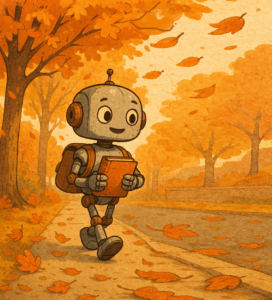Welcome to December 2025’s Spotlight on AI in Education bulletin. With how fast things are moving, this will help you cut through the noise and catch what’s important. The bulletin highlights on-the-ground practice, institutional perspectives and trends in generative AI use across the sector and beyond. We hope you find this useful.
If you have anything you’d like to contribute or see in this bulletin, please email EE@sussex.ac.uk .

Sussex Events and Training
Recent Event:
The Teaching with AI Community of Practice met on Monday 1st December and heard from colleagues across the university.
- Dr Charlie Crouch (EE) and Dr Keith Perera (ESW) reported on a project investigating student use of AI in Further Education. Insights included that over 75% of 13-18 year old students in the UK use AI to help with their homework, while fewer than half feel confident they can identify incorrect AI output. (Teaching the AI-Native Generation – Empowering Schools in the Age of AI. Oxford University 2025. See more: Teaching_the_AI_Native_Generation.pdf )
- Michelle Ansell (MAH) shared some of the challenges of protecting academic integrity in the online pre-sessional English course, and incorporating AI to support students. A popular theory to discourage inappropriate AI use is to make tasks more personal to the students, which in the case of an entirely international cohort presents challenges for standardisation and rubric.
- Dr Gabriella Cagliesi (USBS) shared her work using a custom AI chatbot to support learning by programming a LLM to perform different roles, including as a coach, a contrarian and a critic. Students responded well and appreciated the opportunity to engage with the technology. Look out for more from Gabriella in upcoming blogs.
The event was very well-attended and we’re already lining up contributors for the next meeting, which will be on Monday 16th March 2026. Sign up to attend here: Booking for AI Community of Practice March 2026 – Fill in form.
Join the Teams area for the AI Community of Practice here: www.tinyurl.com/sussex-ai-cop and Read more about our previous AI CoPs on the blog.
Self-Paced Training:
Educational Enhancement’s George Robinson has updated the self-paced Canvas module on Artificial Intelligence, including recent developments in Microsoft CoPilot which Sussex staff and students can access using your abc123 login (e.g. hm549@suss…) Enrol in AI at Sussex here.
The JISC Building Digital Capabilitites Toolkit is available for Sussex staff and students and includes a self-audit for AI literacy, followed by suggestions for resources to help build your confidence. Access the toolkit here: https://sussex.potential.ly .
Coming up in January:
The Sussex Digital Humanities Lab will host an AI day on Monday 19th January. More details here: Sussex AI Day 2026 : What’s on : Sussex Digital Humanities Lab : University of Sussex .
Publications
Podcast: Talking to Students about Generative AI. Educational Enhancement’s Dr Sarah Watson has published the latest post from the university’s Learning Matters blog: Sussex colleagues Prof Carol Alexander (USBS) and Prof Thomas Omerod (Psychology) spoke with podcast hosts Prof Wendy Garnham and Dr Heather Taylor about how they engage students in discussions about AI and AI use, including a really amusing and thought-provoking anecdote about what Chat GPT does about the elephant in the room.
Listen to the podcast here on Spotify Episode 12: Talking to Students About Generative AI – Learning Matters Podcast | Podcast on Spotify and/or read the and transcript here: Episode 12: Talking to Students about Generative AI | Learning Matters.
Institutional Perspective
Assessment, AI and Academic Integrity: As we approach the assessment period, we’d like to remind colleagues that Educational Enhancement has published some guidance for incorporating and/or restricting the use of AI in assessed work. Read more, and follow the links to find the tiered statements (integral, assistive, prohibitive) here: Artificial Intelligence in teaching and assessment : Support and guidance : Educational Enhancement : Staff Hub : University of Sussex .
A reminder that the University of Sussex’s Principles for AI in Education are available here: Our principles for Artificial Intelligence (AI) in education : About us : University of Sussex .
Across the Sector
We have two examples from WONKHE this month that we’d like to share:
Firstly, the recording of their Digital and AI skills for the graduate workforce symposium held on 4th December is available here: Education Espresso – a shot of pedagogical inspiration | Wonkhe. Watch to find out the answer to the provocative question What’s the point of universities if AI will do all the work? posed by Victoria Wade, Director, University of London Careers Service, at the Festival of Higher Education in November.
Secondly, WONKHE have introduced their new project Educating the AI generation in which they want to explore how institutions are developing educator AI literacy and practice. Read more, including about what they’ve learnt already, here: High quality learning means developing and upskilling educators on the pedagogy of AI | Wonkhe .
Further Afield
Watch: Chris McCausland, TV comic, winner of Strictly Come Dancing, former software engineer (BSc, Kingston, 2000) presents Seeing into the Future, available here: BBC Two – Chris McCausland: Seeing into the Future. Chris was born with the hereditary eye condition Retinitis Pigmentosa and his sight deteriorated rapidly in his twenties; he is now completely blind. In this programme, in partnership with the Open University, Chris explores how advances in technology, including AI, can be beneficial to people who experience barriers such as visual impairments.
Season’s Greetings and Looking to the New Year
And finally, as we approach Christmas Eve, let’s reflect on the AI of Christmas Past, when in December 2023 we held the first meeting of the Teaching with AI Community of Practice; the AI of Christmas Present, when this month we met for the fourth time; and look forward to the AI Yet to Come! We’ll meet again before the Spring vacation on Monday 16th March 2026. We’ll confirm the focus and send out the calendar invitation nearer the time but the sign-up sheet is ready for you here Booking for AI Community of Practice March 2026 – Fill in form. Please get in touch with ee@sussex.ac.uk to share your suggestions and/or feedback on previous sessions. As always, if you’d like to present then please let us know at the same address.

This was a Spotlight on AI in Education update from Educational Enhancement
- Join the Teaching and Learning with GenAI Community: If you’d like to join the community and be first to hear about events. Get in touch with us and we can add you to the list and dedicated MS Teams community. www.tinyurl.com/sussex-ai-cop
- Disclaimer on any tools not supported at Sussex. Please do not share Sussex, student, colleague, sensitive or personal data via these platforms. Not being supported means they have not passed stringent Data Protection assessments and could put you at breach of policy and legislation. For a list of supported platforms for teaching and learning please visit the Educational Enhancement website.










